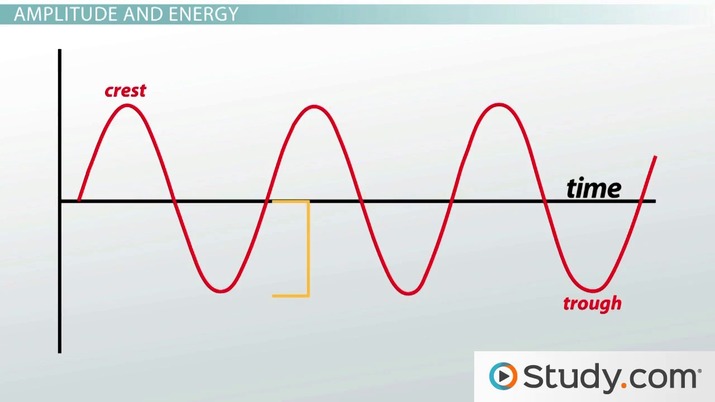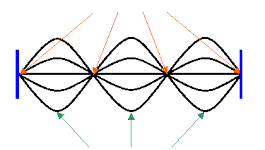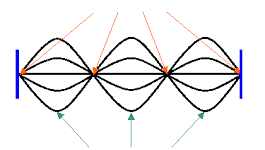Magnetism and Mechanical Waves
1/26
There's no tags or description
Looks like no tags are added yet.
Name | Mastery | Learn | Test | Matching | Spaced |
|---|
No study sessions yet.
27 Terms
If a wire is carrying a strong, steady current, the magnetic field is…
a) proportional to the current and inversely proportional to the distance from the wire
b) proportional to the current and proportional to the distance from the wire
c) inversely proportional to the current and inversely proportional to the distance from the wire
d) inversely proportional to the current and proportional to the distance from the wire
a) proportional to the current and inversely proportional to the distance from the wire
Which conversion process is the basic function to the electric generator?
a) mechanical energy to electrical energy
b) electrical energy to mechanical energy
c) low voltage to high voltage, or vice versa
d) alternating current to direct current
a) mechanical energy to electrical energy
Which conversion process is the basic function to the electric motor?
a) mechanical energy to electrical energy
b) electrical energy to mechanical energy
c) low voltage to high voltage, or vice versa
d) alternating current to direct current
b) electrical energy to mechanical energy
What’s required to induce a current in a wire?
a) motion of the wire
b) uniform magnetic field
c) both of these
d) neither of these
c) both of these
Which statement is true for step-up transformers?
a) secondary turns are fewer than primary turns
b) secondary voltage is less than primary voltage
c) secondary voltage is more than primary voltage
d) secondary current is less than primary voltage
e) c and d
e) c and d
The direction of the force on a current-carrying wire in an external magnetic field is
a) perpendicular to the current only
b) perpendicular to the magnetic field only
c) perpendicular to the current and to the magnetic field
d) parallel to the current and to the magnetic field
c) perpendicular to the current and to the magnetic field
What is the path of an electron moving perpendicular to a uniform magnetic field?
a) straight line
b) circle
c) ellipse
d) parabola
b) circle
What is the path of an electron moving parallel to a uniform magnetic field?
a) straight line
b) circle
a) straight line
Consider two long, straight, parallel wires, each carrying a current. If the currents move in opposite directions…
a) the two wires will attract each other
b) the two wires will repel each other
c) the two wires will exert a force on each other
d) neither wire will exert a force on the other
b) the two wires will repel each other
Consider two long, straight, parallel wires, each carrying a current. If the currents move in the same direction…
a) the two wires will attract each other
b) the two wires will repel each other
c) the two wires will exert a force on each other
d) neither wire will exert a force on the other
a) the two wires will attract each other
A magnetic field is directed to the north, a proton experiencing the field is moving toward the ground, what direction is the proton accelerating?
a) north
b) south
c) east
d) west
c) east
An electron moved through a wire directed into the page and experiences a magnetic force directed up the page. Where will the magnetic field be directed?
a) left across the page
b) right across the page
c) no field is necessary
b) right, across the page
In a magnetized substance, the domains
a) are randomly oriented
b) cancel each other
c) line up mainly in one direction
d) can never be oriented
c) line up mainly in one direction
A current in a long, straight wire produces a magnetic field. These magnetic field lines
a) go out from the wire to infinity
b) come in from infinity to the wire
c) form circles that pass through the wire
d) form circles that go around the wire
d) form circles that go around the wire
What is the orange line representing?
the amplitude

How are frequency and period related in simple harmonic motion?
a) they are directly related
b) they are inversely related
c) they both measure the time per cycle
d) the both measure the number of cycles per unit of time
b) they are inversely related
Sound waves
a) are a part of the electromagnetic spectrum
b) do not require a medium for transmission
c) are longitudinal waves
d) are transverse waves
c) are longitudinal waves
Which statement about sound waves is correct?
a) they generally travel faster through solids than through gases
b) they generally travel faster through gases than through solids
c) they generally travel faster trough gases than liquids
d) they generally travel faster than light
a) they generally travel faster through solids than through gases
At a fixed boundary, waves are
a) neither reflected not inverted
b) reflected but not inverted
c) reflected and inverted
d) inverted but not reflected
c) reflected and inverted
At a free boundary, waves are
a) neither reflected not inverted
b) reflected but not inverted
c) reflected and inverted
d) inverted but not reflected
b) reflected but not inverted
Standing waves are produced by any periodic waves of
a) any amplitude and wavelength traveling in the same direction
b) the same amplitude and wavelength traveling in the same direction
c) any amplitude and wavelength traveling in the opposite direction
d) the same frequency, amplitude, and wavelength traveling in opposite directions
d) the same frequency, amplitude, and wavelength traveling in opposite directions
What are the orange arrows pointing to?
a) nodes
b) antinodes
nodes

What are the green arrows pointing to?
a) nodes
b) antinodes
b) antinodes

What is the fewest number of nodes a standing wave can have?
a) 1
b) 2
c) 3
d) 4
b) 1
If you looked at a light through the lenses from two perfect polarizing lenses that were overlapped at right angles to one another…
a) all of the light would pass through
b) most of the light would pass through
c) little of the light would pass through
d) none of the light would pass through
d) none of the light would pass through
Beats are formed by the interference of two waves
a) of slightly different frequencies traveling in the same direction
b) of slightly different frequencies traveling in different directions
c) with equal frequencies traveling in the same direction
d) with equal frequencies traveling in different directions
b) of slightly different frequencies traveling in different directions
As a train starts from rest then accelerates down the track, coming toward an observer faster and faster, the frequency of the sound waves coming toward the observer will be
a) less than the source frequency
b) constantly increasing in frequency
c) stationary
d) greater than the source frequency
d) greater than the source frequency